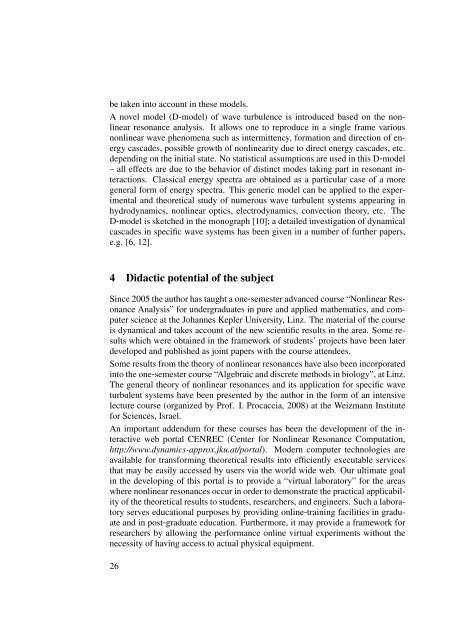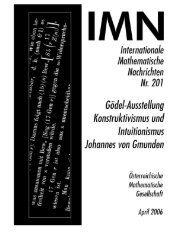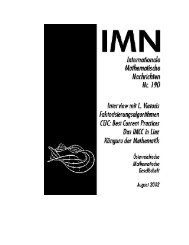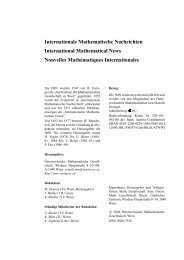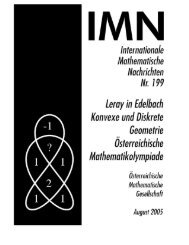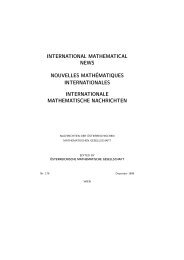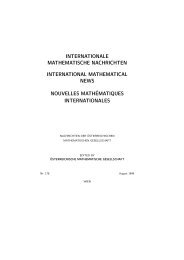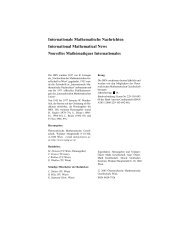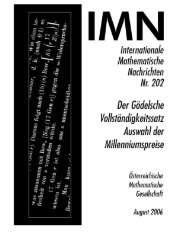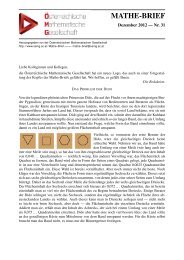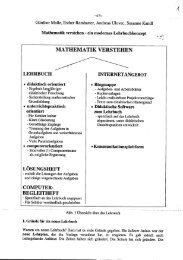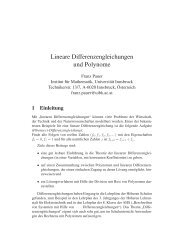218 - Ãsterreichische Mathematische Gesellschaft
218 - Ãsterreichische Mathematische Gesellschaft
218 - Ãsterreichische Mathematische Gesellschaft
Erfolgreiche ePaper selbst erstellen
Machen Sie aus Ihren PDF Publikationen ein blätterbares Flipbook mit unserer einzigartigen Google optimierten e-Paper Software.
e taken into account in these models.<br />
A novel model (D-model) of wave turbulence is introduced based on the nonlinear<br />
resonance analysis. It allows one to reproduce in a single frame various<br />
nonlinear wave phenomena such as intermittency, formation and direction of energy<br />
cascades, possible growth of nonlinearity due to direct energy cascades, etc.<br />
depending on the initial state. No statistical assumptions are used in this D-model<br />
– all effects are due to the behavior of distinct modes taking part in resonant interactions.<br />
Classical energy spectra are obtained as a particular case of a more<br />
general form of energy spectra. This generic model can be applied to the experimental<br />
and theoretical study of numerous wave turbulent systems appearing in<br />
hydrodynamics, nonlinear optics, electrodynamics, convection theory, etc. The<br />
D-model is sketched in the monograph [10]; a detailed investigation of dynamical<br />
cascades in specific wave systems has been given in a number of further papers,<br />
e.g. [6, 12].<br />
4 Didactic potential of the subject<br />
Since 2005 the author has taught a one-semester advanced course “Nonlinear Resonance<br />
Analysis” for undergraduates in pure and applied mathematics, and computer<br />
science at the Johannes Kepler University, Linz. The material of the course<br />
is dynamical and takes account of the new scientific results in the area. Some results<br />
which were obtained in the framework of students’ projects have been later<br />
developed and published as joint papers with the course attendees.<br />
Some results from the theory of nonlinear resonances have also been incorporated<br />
into the one-semester course “Algebraic and discrete methods in biology”, at Linz.<br />
The general theory of nonlinear resonances and its application for specific wave<br />
turbulent systems have been presented by the author in the form of an intensive<br />
lecture course (organized by Prof. I. Procaccia, 2008) at the Weizmann Institute<br />
for Sciences, Israel.<br />
An important addendum for these courses has been the development of the interactive<br />
web portal CENREC (Center for Nonlinear Resonance Computation,<br />
http://www.dynamics-approx.jku.at/portal). Modern computer technologies are<br />
available for transforming theoretical results into efficiently executable services<br />
that may be easily accessed by users via the world wide web. Our ultimate goal<br />
in the developing of this portal is to provide a “virtual laboratory” for the areas<br />
where nonlinear resonances occur in order to demonstrate the practical applicability<br />
of the theoretical results to students, researchers, and engineers. Such a laboratory<br />
serves educational purposes by providing online-training facilities in graduate<br />
and in post-graduate education. Furthermore, it may provide a framework for<br />
researchers by allowing the performance online virtual experiments without the<br />
necessity of having access to actual physical equipment.<br />
26


